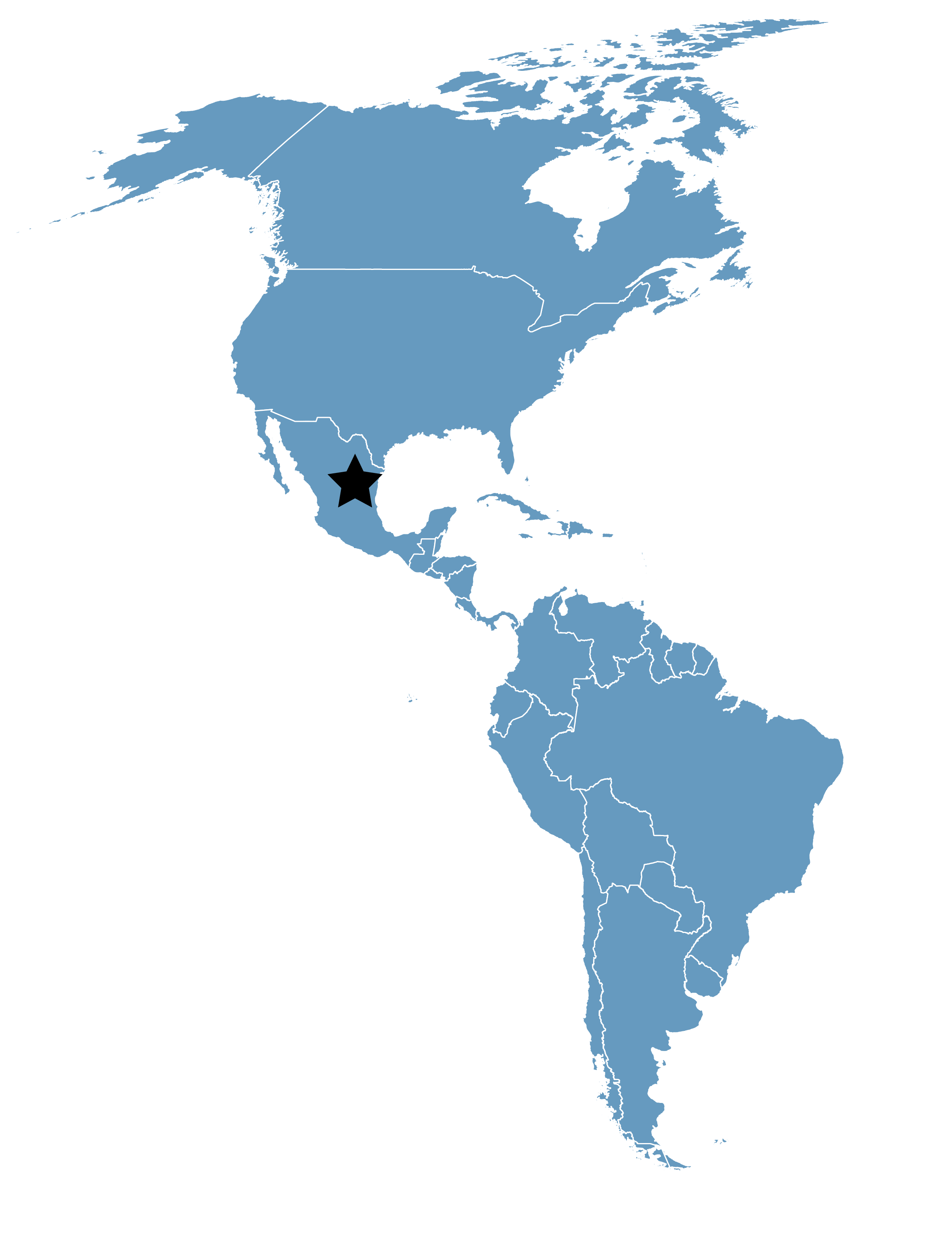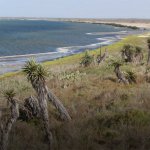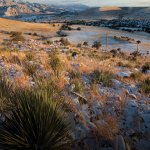Llano de la Soledad
Location
Coahuila, Mexico
Category
International
Basis for Designation
Used by more than 1,500 Mountain Plovers (8.3% of the world population) and 6,000 Long billed Curlews (15% of the world population).
Size
9,000 hectares (22,239 acres)
Date Designated
October 2005
Site Owner
Private and communal lands administered by the Agency of Environmental Protection and Natural Resources of Nuevo León
Site Partners
Pronatura Noreste A.C.
Facultad de Ciencias Biológicas de la Universidad Autónoma de Nuevo León
The Nature Conservancy
PROFAUNA A.C.
Overview
Llano de la Soledad is part of a grasslands complex of 50 colonies of Mexican Prairie Dogs, distributed at the point where the Mexican states of Coahuila, Nuevo León, San Luis Potosí and Zacatecas meet. This region’s grasslands house the largest concentrations of various grassland birds, including some very vulnerable species such as Mountain Plover Charadrius montanus, Long-billed Curlew Numenius americanus and Upland Sandpiper Bartramia longicauda. It stands out as one of the most fragile open grassland ecosystems with the highest conservation priority for highland wintering shorebirds and birds associated with the North American Central Grasslands biome.
This region’s grasslands house the largest concentrations of…some very vulnerable species such as Mountain Plover (Charadrius montanus), Long-billed Curlew (Numenius americanus) and Upland Sandpiper (Bartramia longicauda).
Llano de la Soledad is where the presence of the prairie dog is the widest and more continuous in Mexico and, possibly, in the whole of North America. The conservation and management of this prairie is important for maintaining healthy populations of highland shorebirds, whose distributions are closely linked to the open grasslands biome of North America. Their population studies show important declines and, for this reason, they have been identified as having a high degree of vulnerability in North America.
Llano de la Soledad is in the Municipality of Galeana, Nuevo León and Saltillo, Coahuila. The site belongs to the Chihuahua desert eco-region which in its southern part is known as the Central Plateau and High Plateau. Llano de la Soledad is a natural area protected at the state level. The region is recognised as an Important Bird Area.
Habitat and Bird Species
The soil of Llano de La Soledad is known for its large amount of plaster. This fact determines the presence of gypshopyllic plants. 80% of the soil has no vegetation, 4% has gramineous plants and 16% grass and shrub. Their diversity and density are very low (33 plant species and 57 plants per square meter) if compared with the potential vegetation that this prairie could hold if the grasslands’ condition was improved. The vegetation is lower than 10 cm high because higher species have been eliminated giving way to the “zacate” species which cattle finds less desirable. The prairie is overgrazed.
The “Llano la Soledad” has very special and unique characteristics that make it stand out as one of the most fragile open grassland ecosystems, of highest conservation priority to conserve the winter populations of grassland shorebirds or those species associated with biome of the Central Grasslands of North America.
Information obtained during recent years enables us to ascertain that over 6,000 Long-billed Curlew and around 1,500 Mountain Plover winter in Llano de la Soledad. It is likely that Llano de la Soledad, with neighboring grasslands of other states, concentrate a more significant number of shorebirds. For this reason, it is quite probable that the region qualifies as a Site of Hemispheric Importance, but shorebird populations need to be further quantified and a greater awareness must be cultivated among landowners to achieve this.
Worthen’s Sparrow, Spizella whortheni is also present in the region. This is an endemic species of the Mexican High Plateau which was chosen by the Bird Conservation’s Alliance Zero Extinction program as one of the most threatened species of the world. Other vulnerable birds that concentrate on this prairie are Burrowing Owl, Loggerhead Shrike, Sprague’s Pipit, Grasshopper Sparrow, Baird’s Sparrow and Chestnut collared Longspur.
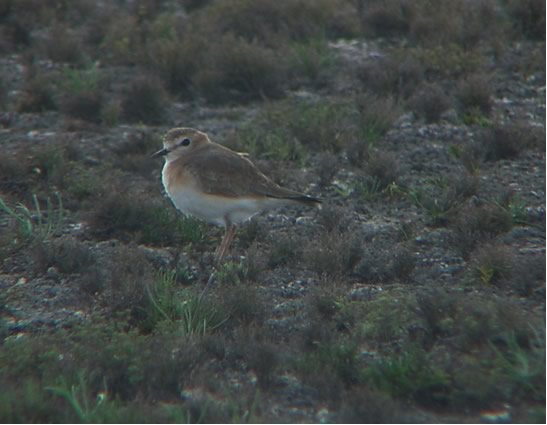
Mountain Plover (Charadrius montanus) in La Soledad. Photo: Miguel Ángel Cruz Nieto – Pronatura Noreste.
Threats and Conservation Action
The region’s open grasslands are strongly threatened by the prosperous potato crops. This accelerated agricultural development takes place without adequate regional planning which causes the loss of the original vegetation cover as well as habitat fragmentation. The shorebird populations are strongly affected by the loss of this critical habitat; each year, over 4,000 hectares are used for crops. The largest part of this land is new land that has been opened to agriculture because it is an area free of diseases, has more nutrients and its yield is, therefore, greater.
The current agricultural production systems have increased their effectiveness through the implementation of synthetic substances made with the aim if improving the product and preventing diseases. Unfortunately, pesticide application by planes, and the lack of containers for toxic residues, generate contamination problems on water resources, concentrate on people and provoke harmful effects, the impact of which has not been evaluated. The agriculture development goes hand in hand with important investments in infrastructure such as roads, electric installations, and larger water requirements.
All these elements affect the landscape. Other elements are habitat fragmentation, bird mortality due to birds crushing against vehicles, and land loss. Agriculture has eliminated 85% of the grassland eco-system since 2003 and the impact of agriculture in the Natural Protected Areas has destroyed 50% of the grasslands in “La Hediondilla”, and 15% in “La Trinidad”. Also, irrigation pivots were established in the neighboring areas of Llano de la Soledad (outside of the natural protected area).
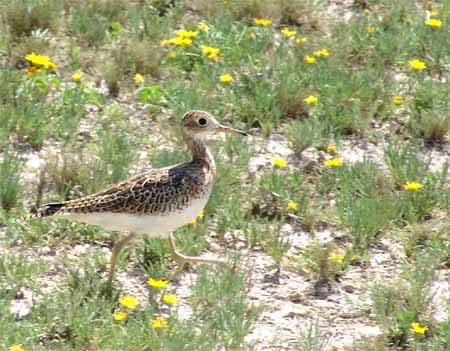
Upland Sandpiper (Bartramia longicauda) in La Soledad. Photo: Miguel Ángel Cruz Nieto – Pronatura Noreste.
The Mountain plover Charadrius montanus is considered in Mexico as a threatened species (NOM-ECOL 2001) and the Long-Billed Curlew Numeniuis americanus was designated by USFWS as one of only 9 focal species in November 2005. Three Prairies in Nuevo León: (1) La Soledad, (2) la Trinidad and (3) La Hediondilla, were declared natural protected areas at state level. Still, agriculture has been established in two of these natural protected areas.
Pronatura Noreste is implementing the Regional Conservation Plan in collaboration with WHSRN, TNC and other partners. In this plan, Llano de la Soledad has been identified as having the highest priority. The plan includes the integration of the planning team, the definition of the grassland’s geographical boundaries, and the spatial distribution of the conservation objectives. Threats, strategies, actions aimed at reducing these, and the measurement of success were also included. Additionally, the plan includes a strong education and legal land protection component that considers land purchase, limitations on its use through Ecological Conservation Easements, and the acquisition of profit grazing rights.
Two portions of land in this prairie have been protected at present. These amount to 7,064 ha, representing 50% of the prairie: La Carbonera (3,246 received protection through a profit right for a period of 20 years, and the use limitation of Rancho Los Arrieros (3,818 ha), received protection through an Ecological Easement.




